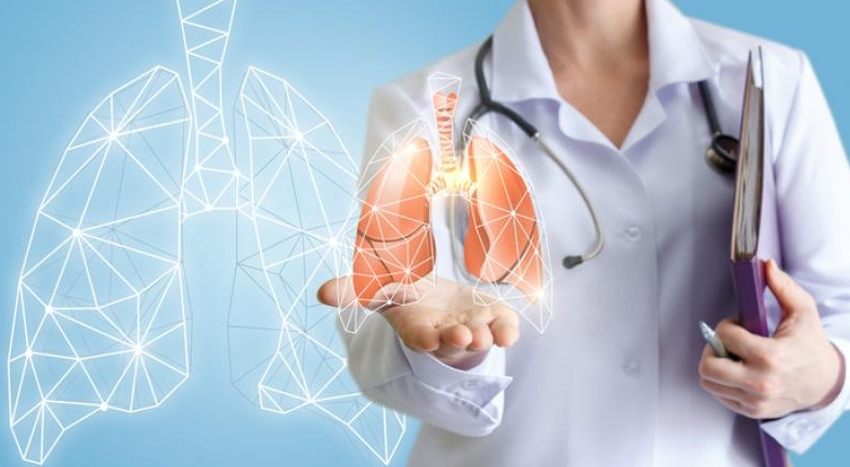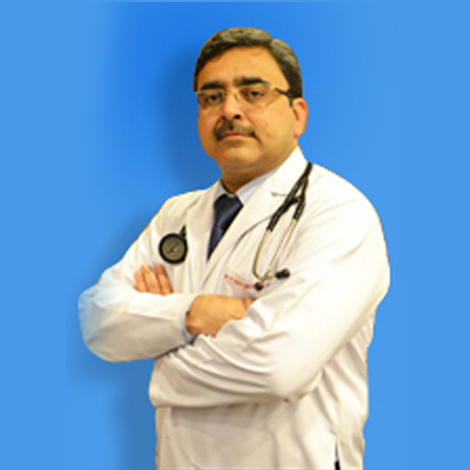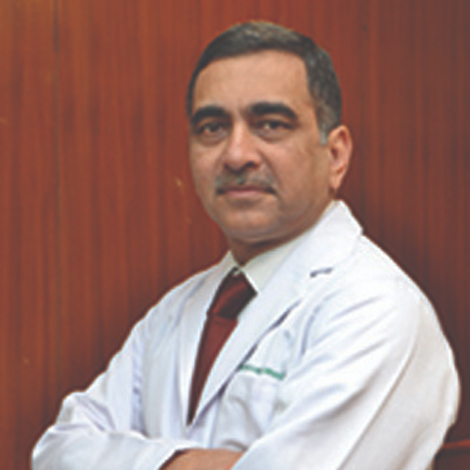Chest Medicine
It provides all that is necessary for high quality care of patients' viz. excellent manpower resources in its consultants and post graduate residents, state-of-the-art equipment required for diagnosis and treatment of respiratory diseases, a human approach combined with total dedication and academic activities to always remain abreast with the latest developments in the field of respiratory medicine.
The department has a fully equipped pulmonary function test laboratory able to perform spirometry, lung volume and diffusion studies-in short a comprehensive lung function testing facility.
Bronchoscopy is an integral part of the diagnostic and therapeutic armamentarium of any modern pulmonology unit and we have a videobronchoscopy unit which enables high resolution imaging as well as performance of procedures such as transbronchial lung biopsies, transbronchial needle aspirations as well as the routine sample collection.
Allergy testing and immunotherapy are making a comeback in the management of allergic respiratory diseases and this department offers the full range of allergy tests.
With an intensive care unit in the hospital, which compares with the best in the world, we are able to offer treatment to patients with respiratory failure due to any cause and this is supported by a huge expertise within the department in non-invasive ventilatory support both within the hospital and for domiciliary care.
Advice on domiciliary oxygen therapy to enable patients with chronic respiratory failure to lead useful quality lives and pulmonary rehabilitation to help the same group of patients is some of the other areas which are developing rapidly within the department.
With the ever increasing burden of respiratory diseases, we in Sir Ganga Ram City Hospital 's department of chest medicine, offer services that we can say are at par with the best in the world.
Asthma
Asthma is a long-term (chronic) disease of the airways which are involved in carrying air in and out of the lungs. Its symptoms are caused by inflammation, which makes the airways red, swollen, narrower and extra-sensitive to irritants. This leads to recurrent attacks of wheezing, breathlessness, chest tightness and coughing. Asthma does not stay the same, but changes over time, and every person with asthma has good and bad days. However, if asthma is properly treated, one can enjoy long periods without symptoms or attacks. The causes of asthma are not fully understood. Asthma is usually caused by a mixture of hereditary (which a person is born with) and environmental factors.
Allergens from house dust mites and pets are the most common causes, but many other allergens, such as pollen and moulds, can cause asthma. Some patients with asthma have no obvious allergies.
Treatment of asthma requires two types of medicines, preventers and relievers. Preventers are medicines that prevent asthma attacks from starting. The most effective and most commonly used preventer medicines are inhaled glucocorticosteroids. Reliever medicines, like inhaled salbutamol, Salmeterol etc, provide rapid relief from an asthma attack by quickly opening up the narrowed airways (dilating the bronchi).
Asthma is under diagnosed and under treated. Worldwide, approx. 180,000 deaths annually are attributable to asthma. Asthma places considerable limitations on the physical, emotional, social, and professional lives of suffer. Children can become very distressed by their disease with considerable absences from school and reduced participation in family life.
The department of chest medicine fully realizing the requirements of asthma patients, has adopted the six-point management plan, as per the GINA guidelines, which involves-
- Educating patients to develop a partnership in asthma management
- Accessing and monitoring asthma severity with symptom reports and measures of lung function as much as possible.
- Avoiding exposure to risk factors.
- Establishing medication plans for chronic management in children and adults.
- Establishing individual plans for managing exacerbations.
- Providing regular follow-up care.
Tuberculosis (TB)
Tuberculosis (TB) is a communicable, but curable bacterial infection caused by Mycobacterium tuberculosis. The lungs are primarily involved, but the infection can spread to other organs
TB is spread through the air when a person with TB in the lungs or throat coughs or sneezes, sending TB germs in the air. When other people breathe in these germs they may become infected. The primary stage of the infection is usually asymptomatic (without symptoms). Pulmonary TB develops in the minority of people whose immune systems do not successfully contain the primary infection. In this case, the disease may occur within weeks after the primary infection. TB may also lie dormant for years and reappear after the initial infection is contained.
This TB 'infection' becomes ' disease' when the body's defenses are weakened, due to aging, a serious illness, stressful event, drug or alcohol abuse, HIV infection (the virus that causes AIDS) or other conditions. When inactive TB germs become active, they multiply and damage the lungs or other parts of the body and the disease develops. Only about 10% of people infected with TB germs develop TB disease.
Patients of TB may develop some or all of the following symptoms-
- Cough for more than 3 weeks
- Fever esp. evening rise fever
- Weight loss
- Loss of appetite
- Night sweats
- Sputum with or without blood
- Chest pain
A few patients may not have any or very mild symptoms initially and their disease is detected at a much later stage when the disease is far advanced.
Tests required for diagnoses of TB are
- Chest X-ray
- Sputum test to look for TB germs (AFB smear and culture)
- Tuberculin skin test (Montoux test)
- Quantiferron - G test for diagnosis of latent or active infection
- Bronchoscopy
- CT scan
- Thoracentesis
Rarely, biopsy of the affected tissue (typically lungs, pleura, or lymph nodeTreatment of tuberculosis requires a six to nine month course with a combination of special antibiotics. (Occasionally the course of treatment may take longer). The antitubercular treatment is with combinations of rifampin , isoniazid , pyrazinamide , ethambutol , or occasionally others. The treatment requires regular supervision to check for any side effects and make sure treatment is completed. People with TB can continue treatment and normal activities when they are not infectious.
People with TB can be cured if they complete treatment. In most cases, after 2 weeks of taking medication, patients with TB disease will no longer spread germs.
Irregular drug taking may cause serious reactions, and the development of drug resistance (MDR-TB), which can be difficult to treat. Therefore it is important to take complete treatment.
Pneumonia
Pneumonia is an infection of the lungs. Pneumonia is a serious illness that can be life-threatening if not treated, especially for persons who are older than 65 years, alcoholic, have underlying medical problems, or have a weakened immune system. Pneumonia can be caused by a variety of microorganisms, including viruses, bacteria, and less commonly, fungi.
Here we will focus on community-acquired pneumonia (CAP), which refers to pneumonia that develops in people in the community, not in a hospital, nursing home, or assisted-living facility.
The mouth and respiratory tract are constantly exposed to microorganisms as air is inhaled through the nose and mouth. However, the body's defenses are usually able to prevent the lungs from becoming infected. CAP develops when a person's defenses are not adequate or the microorganism is particularly strong. As microorganisms multiply, the alveoli become inflamed, red, and accumulate fluid. These changes lead to the symptoms of pneumonia.
Common symptoms of pneumonia include fever, a cough that produces green or yellow sputum, chest pain, a rapid heart and breathing rate, Shaking chills (called rigors) and a change in mental status (confusion, unclear thinking) can occur.
Some groups are at a greater risk of developing pneumonia. These include persons who:
- Are greater than 65 years old
- Are cigarette smokers
- Are malnourished due to health conditions or lack of access to food
- Have underlying lung disease, including cystic fibrosis, asthma, chronic obstructive pulmonary disease, and emphysema
- Have other underlying medical problems, including diabetes and heart disease
- Have a weakened immune system due to HIV, organ transplant, chemotherapy, or chronic steroid use
- Have difficulty coughing due to stroke, sedating drugs or alcohol, or limited mobility
- Have had a recent viral upper respiratory tract infection
Diagnosis of pneumonia includes a complete medical history and physical examination, a chest x-ray, sputum test to identify the bacteria that caused the pneumonia and help guide antibiotic choice, complete blood cell count (CBC) and sometimes a blood culture.
The goal of treatment for patients with CAP is to treat the infection and prevent complications. Treatment of CAP is usually chosen based upon the common organisms causing pneumonia. Most patients with CAP can be treated at home with oral antibiotics. Others, who are at increased risk for complications, require hospitalization, close monitoring and intravenous antibiotics. It is important to finish the entire course of medication and take it exactly as directed to prevent recurrence with resistant organism and complications.
The department of chest medicine follows the international guidelines prescribed for the treatment of pneumonia and is well equipped to handle such cases with the back up of the state-of-art intensive care unit (ICU).

Why choose Sir Ganga Ram City Hospital?
Why choose Sir Ganga Ram City Hospital?
Sir Ganga Ram City Hospital is one of the trusted hospitals in Delhi as well as in India. There are several grounds that make us the top-most hospital of choice of patients and their family members
- Proven Clinical Excellence - We unceasingly outdo the industry benchmarks in medical outcomes
- High-tech healthcare facilities through cutting edge technology - access to the newest drugs, getting the finest treatment technology as well as the latest digital technology available to support clinical and patient administration structures
- Highly experienced and competent doctors, medical professionals and staffs
- Personalised care - Our hospital's philosophy revolves around providing personalised care for the most comfortable healthcare experience possible.
- Quality & cost-efficient Healthcare - Our commitment to patients of outstanding clinical care and friendly atmosphere that is cost efficient too
- Central location and easy accessibility




